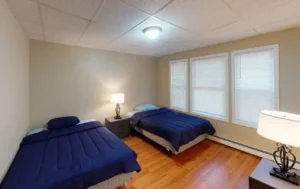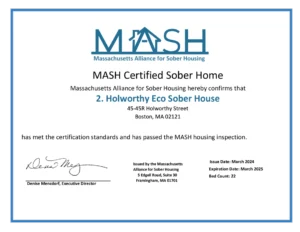
When living in active addiction, the only relationship that mattered was the relationship between you and your substance. Through the help of a built-in community, you will be able to establish meaningful relationships and find value Sober Living in like-minded community. Leaving the structure of the treatment program can be very disruptive to your sobriety, so treatment programs have strict schedules filled with counseling, group therapy, and participatory activities.
The Benefits of Sober Living Homes

A Level I sober living home typically does not have any paid staff and relies on its residents to monitor behavior and enforce policies and procedures. It also provides a therapeutic space where you can get support from peers who are also recovering from substance abuse. There are also specific types of sober living homes that cater to your gender, age, and in some cases, profession.

Is There a Difference Between Sober Living and Halfway Houses?

A sober living house is a peer-managed home designed to help people maintain sobriety. This is achieved through required sobriety, recovery group attendance, and household participation. Those who live in these houses rent rooms indefinitely and live a life in accordance with their responsibilities, like work and school. In fact, the earliest sober living spaces first appeared during the 1830s.
What to Expect in Sober Living Homes
When she’s not researching sustainable alternatives to her everyday products, Lauren is likely attempting to make a dent in her “TBR” book pile. To the best of our knowledge, all content is accurate as of the date posted, though offers contained herein may no longer be available. The opinions expressed are the author’s alone and have not been provided, approved or otherwise endorsed by our advertisers. Dr. Kennedy also suggests touring the home and asking to speak with current residents or alumni.
Common Sober Living House Rules and Regulations
Certain age brackets can experience specific challenges when recovering from addiction. You can enjoy healthy meals in the evening, followed by group therapy sessions. Nighttime is often reserved for free time when you can call loved ones, read books, or watch television.

In some cases, sober living homes will contract with licensed drug rehabilitation centers and therapists as a means for providing an even greater level of care. These types of sober livings do tend to charge higher fees, however, they are often able to provide a very affordable alternative to what would otherwise constitute high-priced inpatient treatment. Embracing these benefits, you’ll find that sober living homes offer much more than just a place to stay. They furnish you with the tools, support, and structure needed to build a solid foundation for your recovery journey. Living among peers who are also committed to a sober lifestyle offers a unique form of support and understanding. This sense of belonging can significantly reduce feelings of isolation and increase your motivation to maintain sobriety.
Should You Go to a Sober Living House?
- Nestled in a quiet waterfront corner of downtown Manhattan, TriBeCa is one of New York City’s most desirable neighborhoods.
- So if you’re ready to take that brave step toward sobriety, know that sober living homes are ready to welcome you with open arms and a path forward.
- Even the most highly motivated people can find it hard to remain sober if there are drugs or alcohol in their living space when they are newly sober.
- In her clinical work, she specializes in treating people of color experiencing anxiety, depression, and trauma through depth therapy and EMDR (eye movement desensitization and reprocessing) trauma therapy.
- Living in a sober home teaches you valuable life skills that aid in your independence.
- Read on to learn more about sober living houses, including how they function, whether one may be right for you or a loved one and how to find a reputable facility in your area.
However, sober living houses are not covered under insurance since they do not provide treatment services and thus aren’t considered rehabilitative facilities. Sober living houses and halfway houses are often used interchangeably as they both provide a substance-free living environment for those suffering from addiction. Differences between the two can stem from funding, length of stay, and requirements to apply to live there. Sober living homes typically do not limit the length of stay and may not require previous attendance in a formal addiction treatment program. Halfway houses, on the other hand, typically have a time limit and require residents to either be attending a treatment program or have recently completed one.
The History of Sober Living
Also, the professional family consultants at Therapy Insider recommend to have at-risk young adults receive direction away from the negative influences of unsupportive peers. Program staff should have proper training and accreditation, and the residence should submit to regular inspections to ensure the highest standard of care. Additionally, many https://ecosoberhouse.com/ programs work in conjunction with an addiction treatment program. If you’re seeking recommendations for sober living in the Houston area, we can help. If you think a sober living house might be the best environment for you as you prepare for your next step in your sobriety journey, ensure that the facility you are considering is properly run.
- They’re often in recovery themselves, offering unique insights and empathy based on personal experiences.
- Nighttime is often reserved for free time when you can call loved ones, read books, or watch television.
- Job placement programs and educational opportunities are also available to help residents reintegrate into society as productive, sober individuals.
- If left unchecked, anger can have a negative impact on your health and your lasting sobriety.
- Avenues NYC sober livings are comfortable, casual, safe environments where residents can forget about the stressors of the outside world and focus on their own growth.
Different Types of Sober Living Homes

These facilities were typically run by the YMCA, YWCA, the Salvation Army, or other like-minded religious groups. Often called dry hotels or lodging houses, these sober living spaces were an outgrowth of the Temperance Movement and offered a safe space for people to escape any societal pressure to drink. Avenues NYC is not an addiction treatment, rehabilitation, medical or health services organization. The services and facilities provided by Avenues NYC (collectively, “Services”) do not include, comprise or involve any form of medical advice, oversight, diagnosis, care or treatment.
Caz Recovery Somerset House
When you embark on the path to sobriety, finding a supportive environment is crucial. They’re not just a place to live; they’re designed to support your recovery and prevent relapse by providing a structured, substance-free environment. Here’s how sober living homes can make a difference in your recovery process. When embarking on the journey of sobriety, the importance of a supportive community cannot be overstated.
